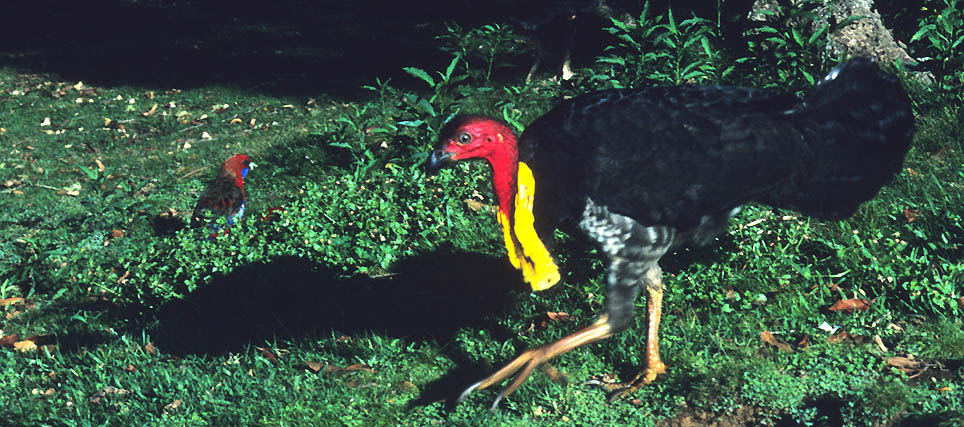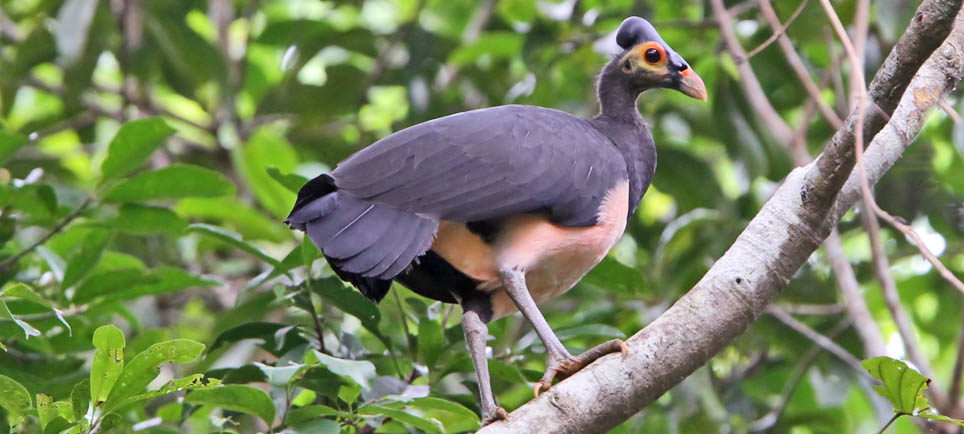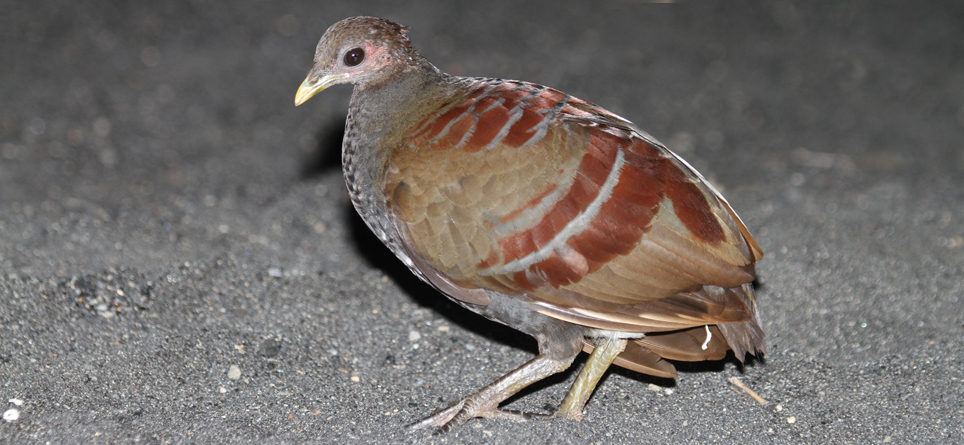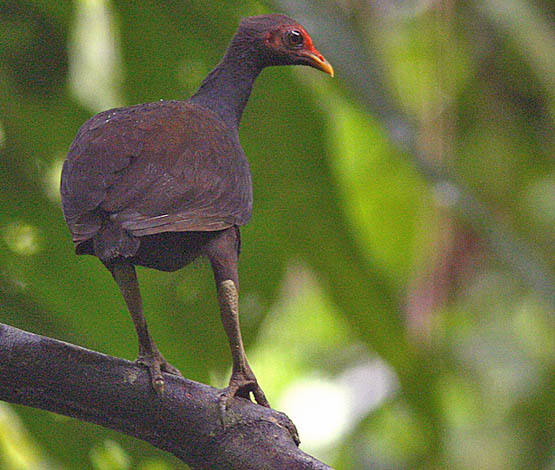
a web page by Don Roberson |
 |
MEGAPODES Megapodiidae |
|
The largest mound-builder is the Malleefowl of the dry mallee scrublands of Australia (above and left; the latter a close-up of a male by Hans & Judy Beste). Huge mounds are built, mostly by the male of a strongly-bonded pair, in which the female lays 15-24 eggs. The male check the temperature daily with its bill, and adds or scrapes off the dead plant material as needed to maintain a steady temperature [29-35 deg C = 84-95 deg F]. It takes over 2 months (62-62 days) for an egg to hatch. The baby digs its way out of the mound and runs off to forage in the mallee on its own. There is no post-hatching parental care. Rather, the male tends the mound for 9-11 months of the year. Two friends and I crept up on the large mound, shown in photo above, on a cold November morning and watched the male "check the temperature." Shortly after the male walked off, we were shocked to see a precocial youngster dig out from the side of the mound and go running off in the opposite direction! |
 |
The name Megapodiidae literally describes the "huge feet." We can see the very big feet and claws of the Australian Brushturkey above (near a Crimson Rosella). The six species of brushturkeys are also mound-builders. Australian Brushturkey inhabits forests of eastern Australia; the remaining five species [in genera Aepypodius and Talegalla] reside in New Guinea or nearby small islands, where they are shy and elusive, and much more often heard vocalizing than seen. It takes a male Australian Brushturkey an average of 37 days to build a mound of leaves, soil, twigs and sticks with its big feet. The largest mounds may have up to 6 tons of material (Elliott 1994). From a birders' perspective, the Megapodiidae have two "superstar" species. One is Malleefowl — huge and mound-centric — but the other is the elusive and enigmatic Maleo of Sulawesi (below in a fine shot by Rob Hutchinson). For one thing, Maleo is often arboreal and apparently spends the nights high in trees. For another thing, Maleo lay eggs in burrows, either using geothermal sites where hot steam will incubate the eggs, or digging in the sand on solar-heated beaches. Maleo live semi-colonially and colonies often lay eggs in the same burrows. The bony casque and salmon-pink wash to lower breast and belly just add to the unique properties of this prized endemic. |
 |
The one scrubfowl in a separate genus [Eulipoa] is Moluccan Scrubfowl (below in a lovely nighttime shot by Rob Hutchinson). Not only is in more colorful than most scrubfowl but it breeds on communal nesting grounds on black sand beaches at night. It is thought that Seram breeders fly across the sea at night to black sand beaches on Haruku. These beaches incubate eggs by solar collection during the day. Because many populations lay eggs communally, they are subject to human disturbance and egg collectors, and many populations are considered endangered. I very well remember crossing a river delta aboard flatboats at night to land on a black sand beach in the moonlight on Halmahera Island. The sand was warm, as were the tropical breezes, and we could hear rhythmic music from a local disco-bar on the other side of the delta. Rob Hutchinson and local guides bring a few birders here most years. Sometimes they will catch a scrubfowl in a flashlight beam where it will 'freeze' for photos (as here in 2010, which was not my year). More often they are fast flying shapes over the beach. But it is a gorgeous black-sand beach on a warm tropical night with distant drumbeats in your ear. Some might even call it a tropical paradise. |
 |
Photos: The distant Malleefowl Leipoa ocellata was at mound was at Wyperfeld NP, Victoria, Australia, on 11 Nov 1983; Hans & Judy Beste took the close-up photo of a male Malleefowl. The Australian Scrubturkey Alectura lathami was at Lamington NP, Queensland, Australia, in Nov 1983. Rob Hutchinson photographed the arboreal Maleo Macrocephalon maldeo at Tambun, Sulawesi, in Sep 2010. Simon Woolley photographed the Melanesian Scrubfowl Megapodius eremita on New Britain, Papua New Guinea, in July 2008. Rob Hutchinson photographed the Moluccan Scrubfowl Eulipoa wallacei at Galela Beach, Halmahera, Indonesia, in Sep 2010. Uncredited photos © Don Roberson. Credited photos © Hans & Judy Beste, Rob Hutchinson, and Simon Woolley, as credited, and used with permission; all rights reserved. Family Book:
Literature cited:
|
 The
Megapodes are an ancient and unique group of (mostly) ground-dwellers,
primarily in Australasia, that are usually considered the most
primitive of the Galliformes. They are most renowned for their
extraordinary incubation strategies. Within in the family there are
'mound-builders' — who use the heat that is generated as plant matter
decays inside the mound to incubate the eggs — and there are the
'burrowers,' who dig burrows to use geothermal heat as the incubating
agent.
The
Megapodes are an ancient and unique group of (mostly) ground-dwellers,
primarily in Australasia, that are usually considered the most
primitive of the Galliformes. They are most renowned for their
extraordinary incubation strategies. Within in the family there are
'mound-builders' — who use the heat that is generated as plant matter
decays inside the mound to incubate the eggs — and there are the
'burrowers,' who dig burrows to use geothermal heat as the incubating
agent.  The most wide-ranging set of megapodes are the scrubfowl in genus Megapodius. There are 13 species. This is Melanesian Scrubfowl in
New Britain (left, photo by Simon Woolley). Many of these scrubfowl are
incredibly shy but some, as here, will perch off the ground. A fair
number of the scrubfowl have extremely small world populations on small
islands in the south Pacific or Wallacea (Ripley 1960), and are
endangered to varying degrees. Among them are some mound-builders and
some burrowers. There are endemic species in the Nicobars [M. nicobarienses], Sula & Banggai Is. [M. bernsteinii], Vanuata and Banks Is. [M. layardi], Tanimbar Is. [M. tenimberensis], and Biak Is. [M. geelvinkianus]. It would be a lifetime's project to simply see all of the world's scrubfowl.
The most wide-ranging set of megapodes are the scrubfowl in genus Megapodius. There are 13 species. This is Melanesian Scrubfowl in
New Britain (left, photo by Simon Woolley). Many of these scrubfowl are
incredibly shy but some, as here, will perch off the ground. A fair
number of the scrubfowl have extremely small world populations on small
islands in the south Pacific or Wallacea (Ripley 1960), and are
endangered to varying degrees. Among them are some mound-builders and
some burrowers. There are endemic species in the Nicobars [M. nicobarienses], Sula & Banggai Is. [M. bernsteinii], Vanuata and Banks Is. [M. layardi], Tanimbar Is. [M. tenimberensis], and Biak Is. [M. geelvinkianus]. It would be a lifetime's project to simply see all of the world's scrubfowl.